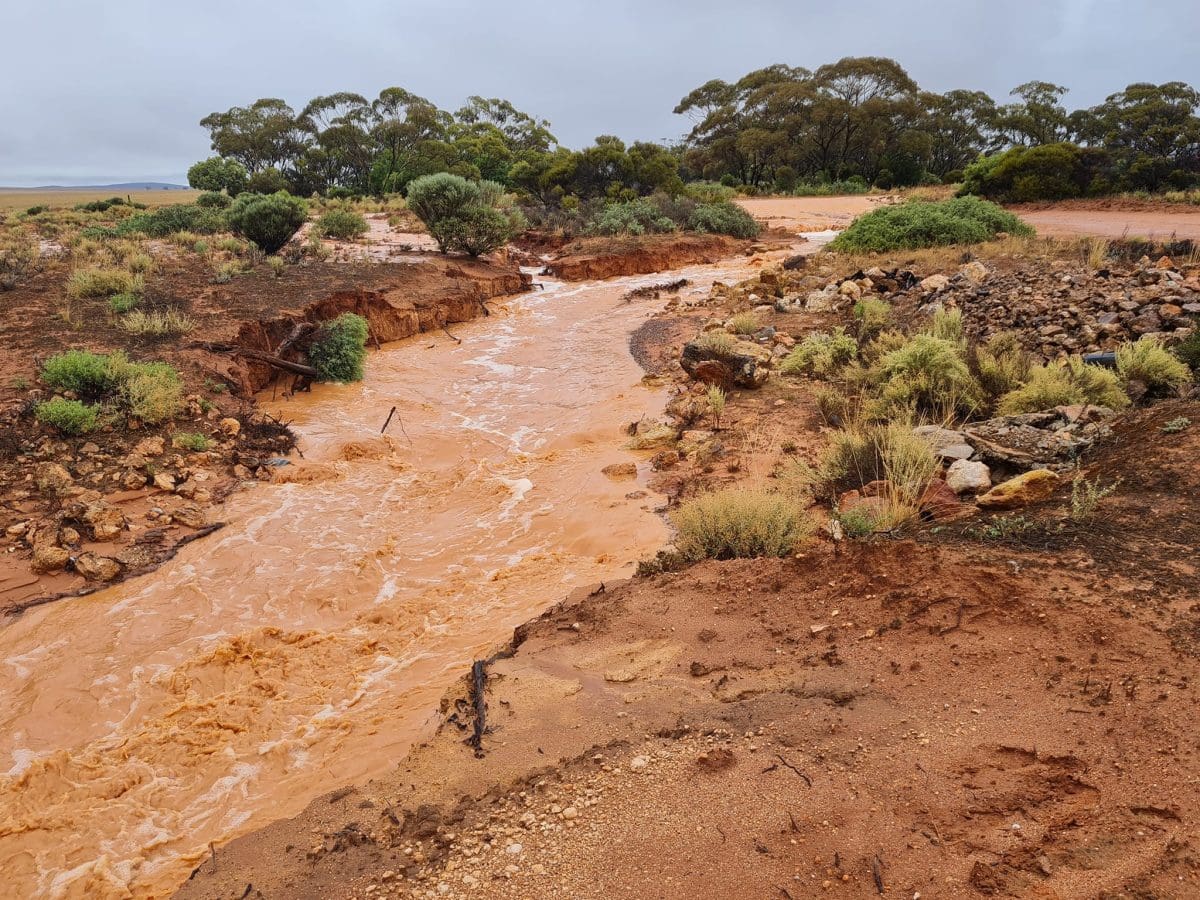
Heavy rain has drenched parts of the Eyre Peninsula, including the Barna-Bunora Road near Kimba. Photo: Kerri Cliff, Fresh Eyre Photography
TORRENTIAL rain over parts of South Australia’s western cropping region in the past week has set the state up for a strong and early start to its 2022 cropping year.
It has also washed away considerable amounts of topsoil in some areas, and has damaged some roads and fences.
Growers on the Eyre and Yorke peninsulas are expected to start planting their winter crops, mostly wheat, barley, canola and lentils, from April.
They mainly produce barley, canola, lentils and wheat, and aim to start their seeding programs in mid-April and finish them in June.
Grower Andrew Polkinghorne at Lock on the Central EP said the full subsoil-moisture profile for most growers has inspired confidence for the 2022-23 cropping season.
“This will put plenty in the profile right through to spring,” Mr Polkinghorne said.
“Especially with high input prices, people have been debating how much crop they’d put in, and at least they can go in with some confidence about yield potential now.”
The Polkinghornes’ farm gauge collected 221 millimetres between Wednesday and today, which compares with the average January rainfall of around 20mm.
“This has never ever happened in my farming career…and that started in 1978,” Mr Polkinghorne said.
“This is the highest registration in the past 100 years, since rainfall records started, for plenty of growers.”
And this one is a bit quicker across the highway. pic.twitter.com/m5ezZWMyC6
— Andrew Polkinghorne (@andrewpolk7) January 21, 2022
Much of the rain fell in the 24 hours to 9am Saturday, and Bureau of Meteorology (BoM) registrations included: Buckleboo 165mm; Darke Peak 152mm; Kimba 160mm, and Port Lincoln 47mm,.
However, parts of the EP and Western Agricultural region missed out on rain, according to official registrations in the week to 9am today.
In the week reported, other registrations included: Elliston 32mm; Minnipa Research Centre 48mm; Wirrulla 132mm, and Winter Springs, southeast of Kimba, 228mm.
Topsoil losses appear to have been considerable for some growers, particularly where ground cover was minimal.
“The no-till systems have stood up pretty well, and it’s just in high-pressure points where water had some speed up that it did the damage.”
Mr Polkinghorne said the Central EP has just finished a slightly above-average season, and could now hope for something similar or better this year.
Kimba grower Trevor Cliff and family had 185-215mm over the rain event, which puts them well on the way to achieving their annual average rainfall of 300-340mm before January is out.
“There’s never been a rain even like this, I don’t think, in living memory,” Mr Cliff said.
“We’re going to have lots of lagoons around for a while.”
Hay, canola and lentils are likely to be the first crops planted, and Mr Cliff said mixed farmers were already thinking about planting fodder crops into paddocks where sheep had been grazing prior to the wash-outs.
“People will have to start thinking about sheep feed pretty soon, and they might go in with early oats and barley.”
He said bales of hay would be going out to tide sheep over until paddock feed was again available.
Grain Producers SA CEO Brad Perry said the organisation was seeking feedback from grain growers on the damage from rain and flooding so it could convey the information to government.
“Growers in areas of the Eyre Peninsula and Yorke Peninsula are reporting significant damage, with movement of topsoil impacting fences and roads,” Mr Perry said.
“Some areas had up to 320mm of rain in a short period, and they haven’t been able to even see what impact that has had on grain still in bags on their property.”
On YP, weekly registrations included: Kadina 114mm; Maitland 60mm; Price 108mm, and Wallaroo 91mm.
Markets hold up
Viterra and T-Ports operate export terminals on EP, and both have busy shipping programs which are incorporating some rain-affected wheat.
“Prices have been good, and a bit of a saviour, because there’s plenty of wheat around which has a falling number under 200.”
Trade sources and shipping stems indicate this wheat is selling and shipping into mostly Southeast Asian markets, while feed barley is going the same way and into the Middle East.
Traffic SA indicates the Birdseye Highway running east from Cowell is closed in several places due to flooding, and the Eyre Highway is closed west of Kimba.
However, most locations on major routes are expected to reopen from tomorrow once floodwaters recede and repairs can be carried out.
The outturn of grain is not expected to be affected due to adequate stocks already being at port, and alternative routes and all major roads on the western EP being open.

HAVE YOUR SAY